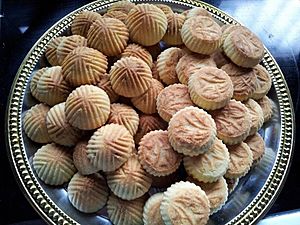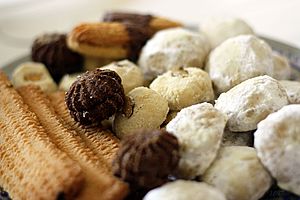Kahk facts for kids
Kahk (also called Ka'ak al-Eid) is a small, round biscuit. It started in Egypt and is now eaten across the Arab world. People enjoy Kahk during special celebrations like Eid al-Fitr and Easter.
This tasty biscuit is usually covered with powdered sugar. It can have different fillings, such as:
- ‘agameya (a sweet mix of honey, nuts, and ghee)
- Turkish delight
- Walnuts or pistachios
- Dates
Sometimes, Kahk is served plain without any filling. The date-filled Kahk might be the first version of ma'amoul, another similar biscuit eaten during Eid in the Levant. Kahk is also popular in Indonesia, where it is called kue kaak. This shows how Arab and Indonesian cultures have mixed. People often serve kue kaak during Mawlid or Eid ul-Fitr.
Kahk is a very important part of Egyptian and Sudanese culture. It's not just for Eid and Easter, when it's often given to guests. It's also eaten at wedding parties and sometimes at other holidays like Christmas and Mawlid.
Making Kahk is a special tradition and a social event. Women from a village or neighborhood, both Christians and Muslims, often gather to bake Kahk together. They chat, share stories, and swap recipes. Sometimes, families prepare their Kahk dough at home. Then, they take it to a shared or commercial bakery to be baked. Families often give Kahk to each other as gifts. Friendly competitions to see whose Kahk is the best are common.
The designs pressed onto Kahk can be very fancy. These designs are a source of pride for Egyptian families. The molds used to make Kahk designs are usually made from wood or ceramic. They are often passed down through generations. While bakeries have always sold Kahk, buying it from stores has become more popular in cities in recent years. However, store-bought Kahk can be quite expensive. So, many Egyptians, especially in rural areas, still prefer to bake their own.
What does Kahk mean?
The word kahk comes from the Coptic language. The Coptic word is ⲕⲁⲏⲕ.
History of Kahk
Kahk is believed to be very old, going back to Ancient Egypt. Pictures showing people making Kahk have been found in old temples in Memphis and Thebes. They have also been found in 3500-year-old tombs from the Eighteenth Dynasty.
Ancient Kahk came in many different geometric shapes. More than 100 designs have been discovered. They were often stamped with a picture of the solar disk. This was a symbol of the sun god Ra. Ancient Egyptians also baked larger, pie-sized Kahk called shurik. They ate these shurik before visiting the tombs of their ancestors. People believed these shurik had magical powers. Kahk stayed popular even as Egypt changed from its old religion to Christianity. It was often served on special days, especially Easter.
Kahk's history in Islamic times began with the Tulunid dynasty. Their bakers made Kahk molds with the words kol wishukr ("eat and thank God"). But Kahk became truly famous under the Ikhshidid dynasty in the 900s. They were the first to include it in the Eid al-Fitr feast.
A minister from the Ikhshidid time, Abu Bakr Mohammed bin Ali al-Madrani, was known for hiding gold dinars (gold coins) inside some Kahk. These special Kahk were then given to the people. This practice became a local legend. Later Egyptian rulers copied it. For example, the Fatimid Caliph spent a lot of money (20,000 dinars) baking and giving out gold-filled Kahk for Eid in 1124 CE. This was such a big job that it had to start in the month before Ramadan. It even needed a special government department called the Diwan al-Fitr.
Another Fatimid Caliph, Al-Aziz, built a very long table (1350 meters). It was piled high with 60 different kinds of Kahk and ghorabiye. Some of these also had gold coins inside. Giving out Kahk was an important way for the Fatimid government to gain public support. It helped keep people happy. It was also a form of propaganda, as Kahk was stamped with messages asking people to be loyal to the state or its leaders.
Archaeologists have found Fatimid-era Kahk molds. They have messages like "eat and thank God your Lord" and "thank Hafeza." Hafeza was an official in charge of making Kahk. This message is also an early example of branding.
When the Sunni Ayyubid dynasty took over from the Isma'ili Shia Fatimids in 1174, Sultan Salah ad-Din tried to stop Fatimid traditions. This included eating Kahk on Eid. But even with his great power, he could not get rid of Kahk. This shows how important this dessert was to Egyptians.
The government started giving out Kahk again under Mamluk rule. The Mamluk Sultans gave out Kahk for Eid and Easter. They especially gave it to groups who needed help, like Sufis, students, and the poor. However, there is no proof that they hid gold coins in their Kahk. Like the Fatimids, the Mamluks gave out Kahk to keep people calm and to build support for their rule. Giving Kahk to the poor continued under Ottoman rule. During the 1300s and 1400s, charitable trusts (called awqaf) were closely linked to baking and giving out Kahk.
During the Islamic period, the Christian cross design on Kahk was replaced. Instead, Kahk had sayings, geometric designs (including the old solar disk images), or artistic pictures of plants. Several Fatimid-era Kahk molds are now shown at the Museum of Islamic Art in Cairo. They are important examples of Islamic art and Arabic calligraphy.
See also
 In Spanish: Kahk para niños
In Spanish: Kahk para niños



